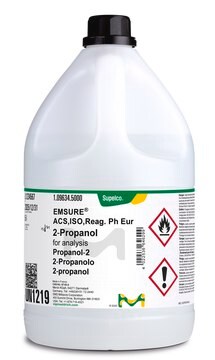1576708
USP
1,2-Propanediol
United States Pharmacopeia (USP) Reference Standard
Sinónimos:
1,2-Propanediol, Propylene glycol
About This Item
Productos recomendados
grado
pharmaceutical primary standard
densidad de vapor
2.62 (vs air)
presión de vapor
0.08 mmHg ( 20 °C)
familia API
propylene glycol
temp. de autoignición
779 °F
lim. expl.
12.5 %
fabricante / nombre comercial
USP
índice de refracción
n20/D 1.432 (lit.)
bp
187 °C (lit.)
mp
−60 °C (lit.)
densidad
1.036 g/mL at 25 °C (lit.)
aplicaciones
pharmaceutical (small molecule)
Formato
neat
cadena SMILES
CC(O)CO
InChI
1S/C3H8O2/c1-3(5)2-4/h3-5H,2H2,1H3
Clave InChI
DNIAPMSPPWPWGF-UHFFFAOYSA-N
¿Está buscando productos similares? Visita Guía de comparación de productos
Descripción general
Aplicación
Also used to prepare standard stock, standard, sample, system suitability, and sensitivity solution for assay and impurity analysis according to the given below monographs of United States Pharmacopeia (USP):
- Propylene Glycol Dilaurate
- Phenytoin Sodium Injection
- Hydroxypropyl Betadex
- Butylene Glycol
Nota de análisis
Otras notas
Producto relacionado
Código de clase de almacenamiento
10 - Combustible liquids
Clase de riesgo para el agua (WGK)
WGK 1
Punto de inflamabilidad (°F)
219.2 °F - closed cup
Punto de inflamabilidad (°C)
104 °C - closed cup
Elija entre una de las versiones más recientes:
Certificados de análisis (COA)
It looks like we've run into a problem, but you can still download Certificates of Analysis from our Documentos section.
Si necesita más asistencia, póngase en contacto con Atención al cliente
¿Ya tiene este producto?
Encuentre la documentación para los productos que ha comprado recientemente en la Biblioteca de documentos.
Los clientes también vieron
Protocolos
99%; Glycerol, ≥99.5%; Tetraethylene glycol, 99%
Nuestro equipo de científicos tiene experiencia en todas las áreas de investigación: Ciencias de la vida, Ciencia de los materiales, Síntesis química, Cromatografía, Analítica y muchas otras.
Póngase en contacto con el Servicio técnico






